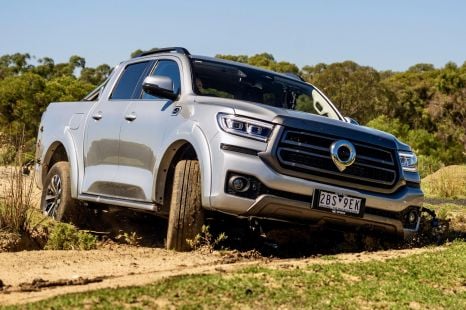

Max Davies
2026 GWM Cannon Ultra review
5 Days Ago
We put Honda's entry-level Civic e:HEV to the test to see if this hybrid hatchback can justify its premium price tag.
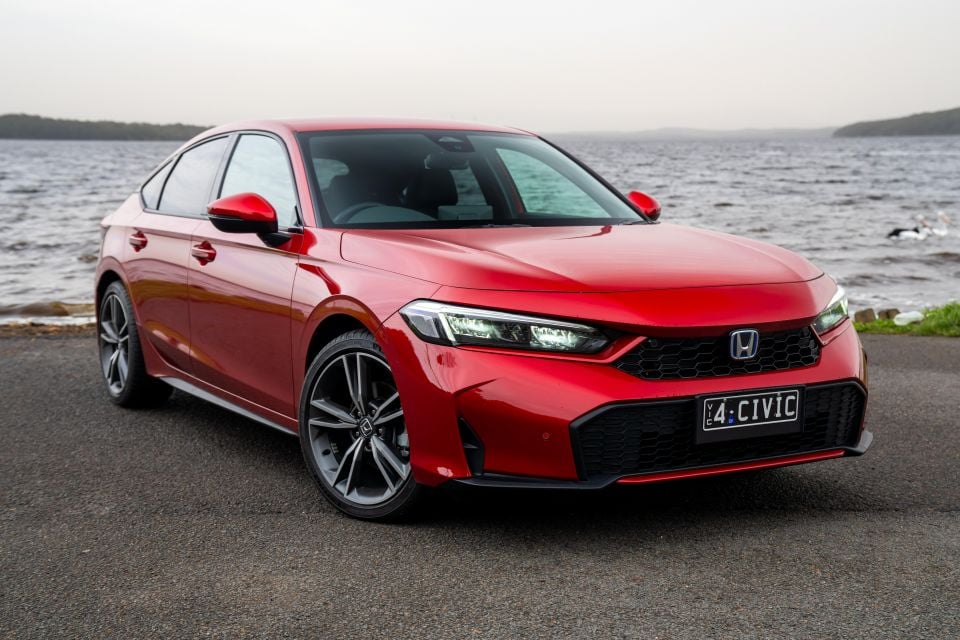
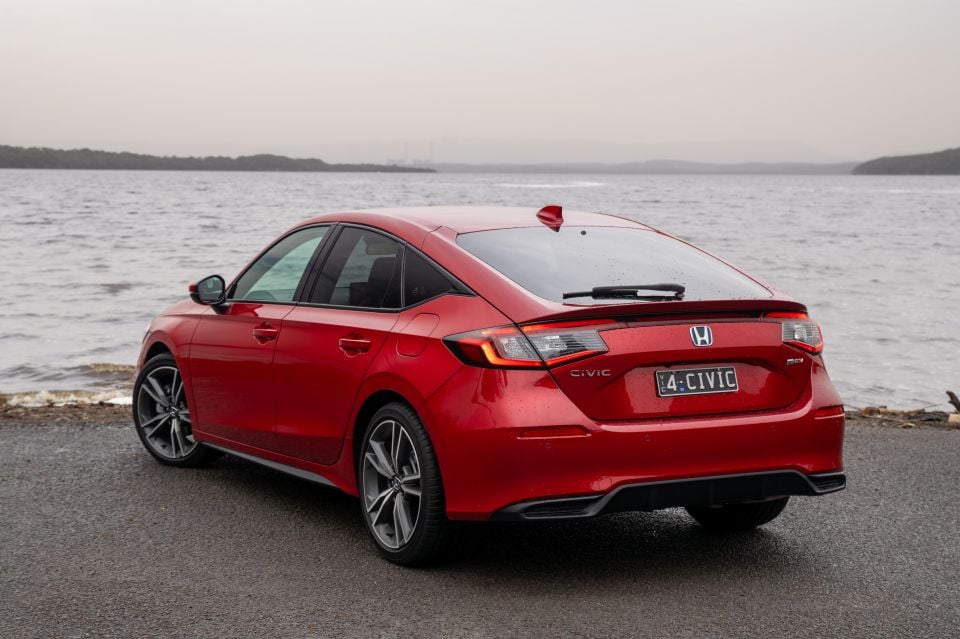

Quickly see how this car stacks up against its competition. Select any benchmark to see more details.
Where expert car reviews meet expert car buying – CarExpert gives you trusted advice, personalised service and real savings on your next new car.
The Honda Civic has been a mainstay of the small car landscape for more than 50 years.

Now, in its 11th generation, it plays a different role for the Japanese brand than it once did, transitioning from a no-frills and affordable entry model into an ultra-efficient alternative to base-level luxury hatchbacks.
It’s an interesting repositioning for one of Honda’s keystone, volume-selling models, and yet it seems entirely logical considering the rising tide of compact SUVs that have taken its place as the default choice for budget-conscious Australian families.
So, where does that leave the Civic now? Well, let’s find out…
The current-generation Honda Civic first launched here in 2022 with a three-variant range that included two high-grade mainstream offerings – with either turbo-petrol or hybrid powertrains – and the flagship, high-performance Type R hot hatch.
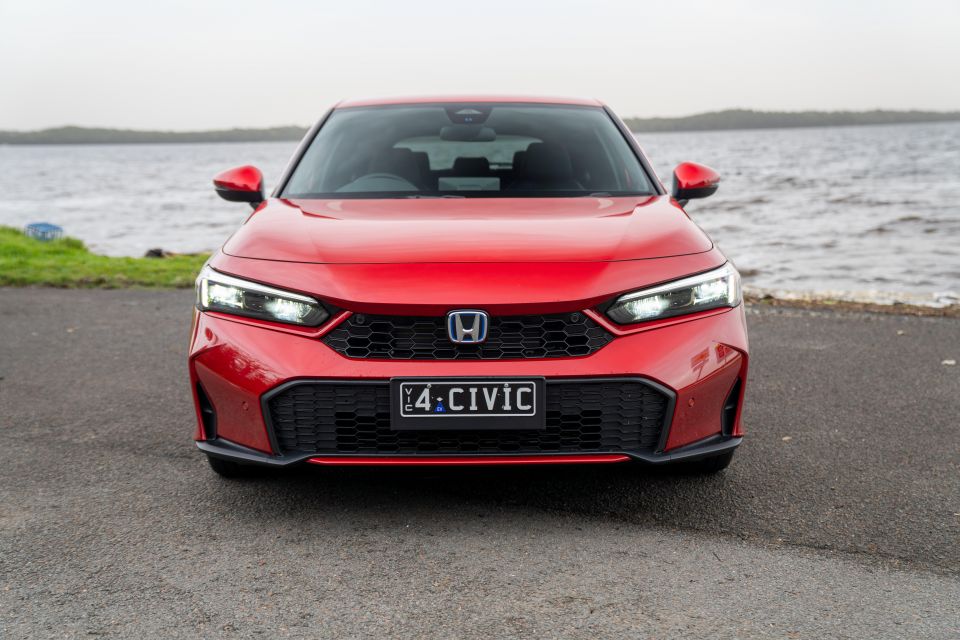
| Model | Drive-away pricing |
|---|---|
| Honda Civic e:HEV L | $49,900 |
| Honda Civic e:HEV LX | $55,900 |
While the Type R continues on unchanged, the regular Civic lineup was updated late last year when Honda axed the entry variant in favour of a pair of hybrid-only variants that brought minor visual tweaks to the front bumper design, new-look 18-inch alloy wheels and upgrades to the infotainment and safety systems.
Consequently, the entry point has moved further upmarket and the range now kicks off at $49,900 drive-away for the Honda Civic e:HEV L we’re testing here, while the flagship LX commands a $6000 premium for its extra features, including full leather interior trim, a panoramic sunroof, power-adjustable front seats and more.
While the sticker prices might cause a bit of shock, both variants are inclusive of all on-road costs, which pitches the L closer to range-topping rivals like the Mazda 3 G25 Astina ($43,310 plus on-roads), Peugeot 308 GT Hybrid (from $48,990) and the Volkswagen Golf R-Line ($47,990).
To see how the Honda Civic lines up against the competition, check out our comparison tool
Buy your new car without the stress. It's fast, simple and completely free.

Great service from Travis and team, second time I have used this business would not hesitate to recommend them to anyone
Craig C.
Purchased a Ford Ranger in Sunshine Coast, QLD
CarExpert helped Craig save $7,224 on his Ford Ranger, now let us save you on your next new car.
Get your BEST priceThere’s a lot to like about the Civic’s cabin, even though it doesn’t present as flashy or particularly modern.
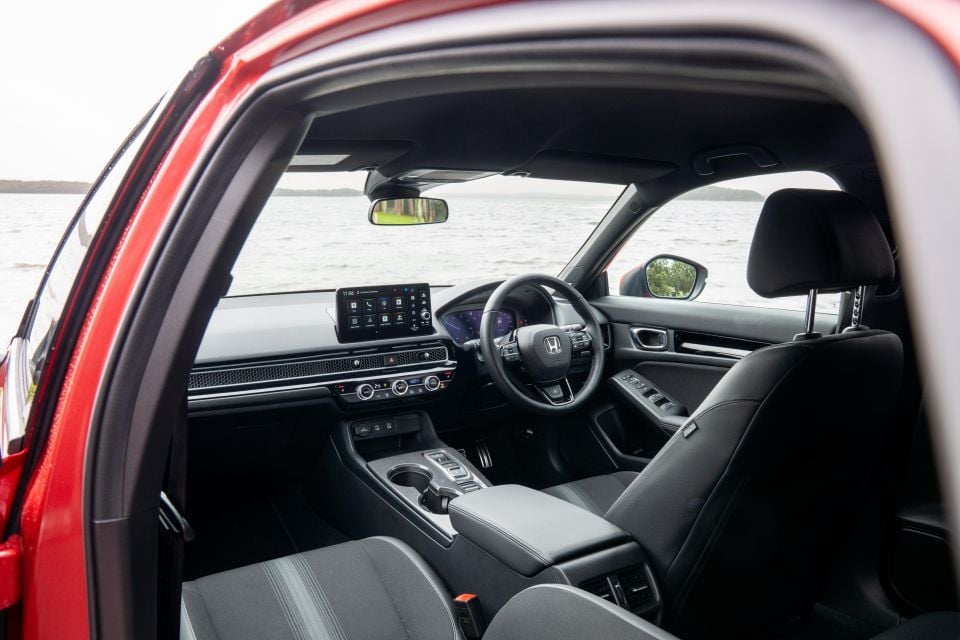
Instead, it gets the fundamentals just right.
The overall aesthetic is rather conventional, with a T-shaped relationship between the dashboard and centre console, which features a decent-sized storage binnacle at its base with two USB-C outlets and a 12V power socket, two large cupholders in the centre and a covered bin between the seats.
In fact, the only unusual element about the Civic’s myriad controls is the push-button gear selector with an indented button to select reverse, and the neat joysticks that poke out of the honeycomb grille to adjust the flow of ventilation from the air vents.
Otherwise, it’s refreshingly uncomplicated, with a block of easily accessible physical buttons and dials in the centre for the dual-zone climate control system, and it’s nice to have a volume knob and buttons for Home and Back on the side of the touchscreen.
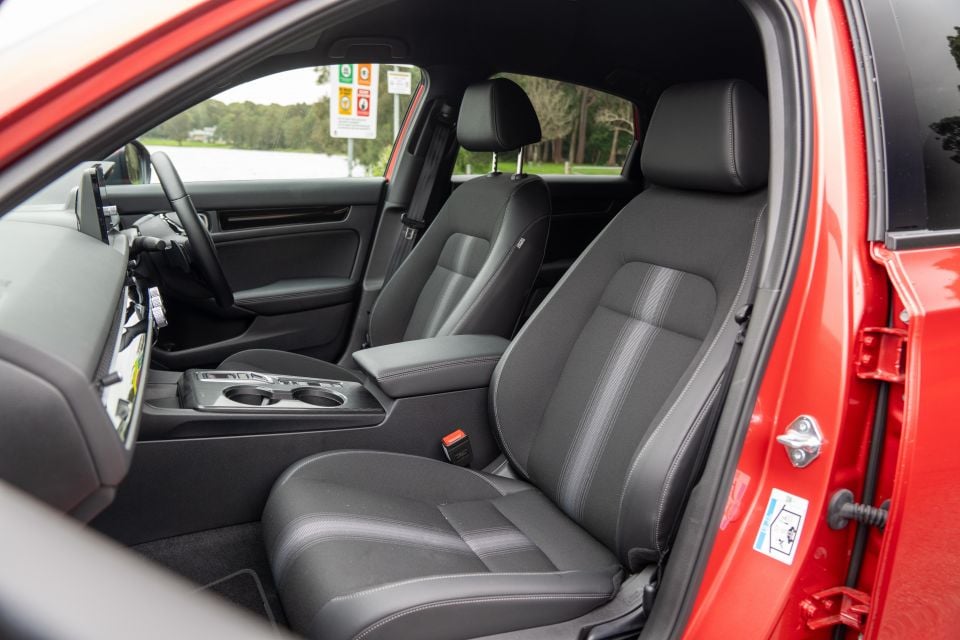
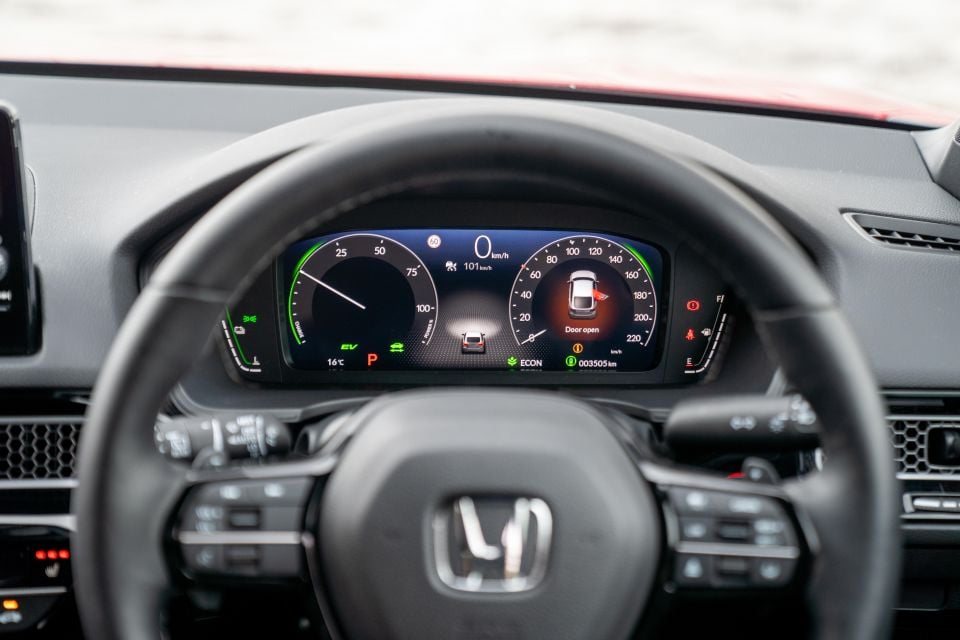


Speaking of which, the 9.0-inch colour display might not be as big as many others in the class, but the menu structure is easy to use with large square icons that are clearly labelled, and the inclusion of embedded Google Maps – as well as voice-activated Google Assistant – makes it simple and more familiar to find new destinations and follow instructions.
The larger 10.2-inch digital instrument cluster is bright and provides all the essential information in a logical layout, with road speed and power output in conventional dials on either side of a multi-function display in the centre, with two simple strips for fuel and battery levels on the outer edges.
The three-spoke steering wheel is the right size too, offers plenty of adjustment in both reach and rake to find the optimum position, and can be heated to take the chill out of early-morning winter commutes, which is nice to have. Plus, the fingertip controls are logically laid out, with audio on the left and cruise control functions – including one-touch access to activate or turn off lane-keeping assistance and set the distance to traffic ahead – on the right.
While there’s no electric adjustment to the front seats in the L model grade, both the driver and passenger are treated to excellent comfort and support with supple cushioning and firm side bolsters, plus three-stage heating. They don’t look fancy, but they are among the best in the business and make it easy to spend hours behind the wheel.

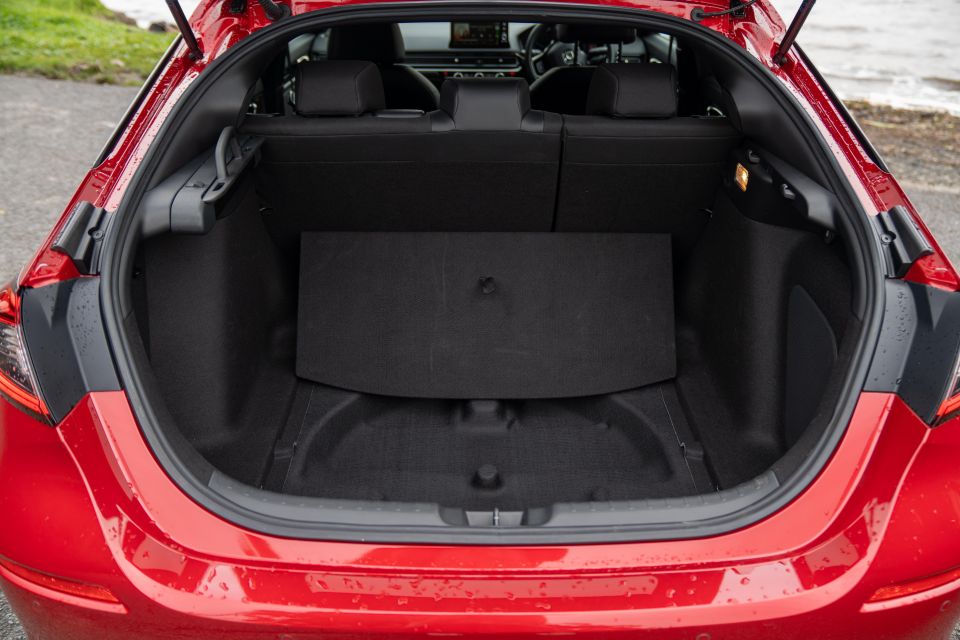
For those in the back, there is a decent amount of rear legroom and enough space to squeeze three across the bench for short trips. The sloping roofline does impact headroom for taller passengers, particularly when compared to a SUV, but the Civic is well suited to small families.
In fact, with 409 litres of cargo capacity in the boot, it offers more room than most other small hatchbacks and even some mid-size soft-roaders. There’s even an additional – albeit shallow – underfloor storage area to secure smaller items or separate wet clothes or sports gear.
| Dimensions | Honda Civic e:HEV L |
|---|---|
| Length | 4569mm |
| Width | 1802mm |
| Height | 1415mm |
| Wheelbase | 2735mm |
| Cargo capacity | 409L |
To see how the Honda Civic lines up against the competition, check out our comparison tool
The Honda Civic e:HEV is powered by a interesting – and more advanced – hybrid powertrain that links a naturally aspirated four-cylinder 2.0-litre direct-injection petrol engine with two electric motors sandwiched within the continuously variable automatic transmission (CVT).
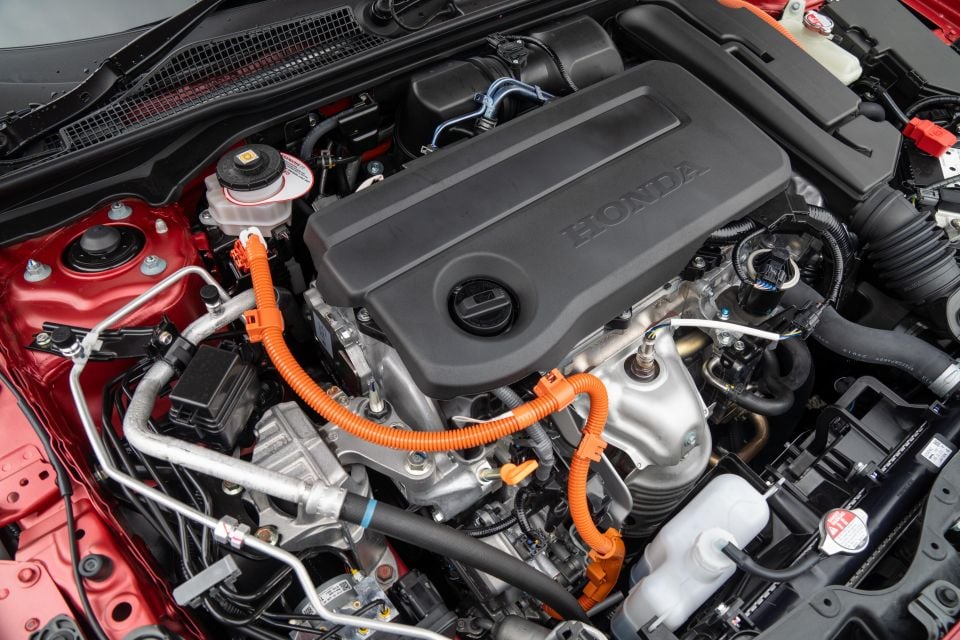
| Specifications | Honda Civic e:HEV L |
|---|---|
| Engine | 2.0L 4cyl petrol-electric HEV |
| Engine outputs | 105kW / 186Nm |
| System outputs | 135kW / 315Nm |
| Battery | 1.0kWh |
| Transmission | CVT |
| Drive type | FWD |
| Weight | 1465kg |
| Fuel economy (claimed) | 4.2L/100km |
| Fuel economy (as tested) | 4.3L/100km |
| Fuel tank capacity | 40L |
| Fuel requirement | 91-octane unleaded |
| CO2 emissions | 96g/km |
The petrol engine uses a lean-burning Atkinson cycle to improve fuel-efficiency, while the e-CVT features both an electric motor generator that is primarily designed to recuperate energy under deceleration to recharge the small 1.0kWh lithium ion battery mounted under the rear seats, and another more powerful traction motor on the back of the gearbox that assists the petrol motor when driving.
Together, they produce a combined maximum power output of 135kW, which is hardly earth shattering. But, the performance you feel comes from its above-average peak torque figure of 315Nm, which is on tap from almost the moment you touch the throttle pedal.
In most situations, the powertrain acts like a regular series-parallel hybrid with the primary electric motor used to get things moving away from a standstill, before the petrol engine chimes in and they work together. The motor/generator can also reverse its flow and provide additional power under heavy acceleration too.
However, unlike other systems such as those in a variety of Toyota models, the Honda can also decouple the petrol engine at cruising speeds and run entirely on electricity.
Now, because the battery capacity is reasonably small, it can’t do this for long durations like a plug-in hybrid would. But it does make a significant improvement to its fuel consumption, particularly around town where Honda claims it has average urban fuel consumption of just 2.0L/100km, and an overall average figure of 4.2L/100km.
To see how the Honda Civic lines up against the competition, check out our comparison tool
How all of that plays out in the real world is almost invisible from behind the wheel.
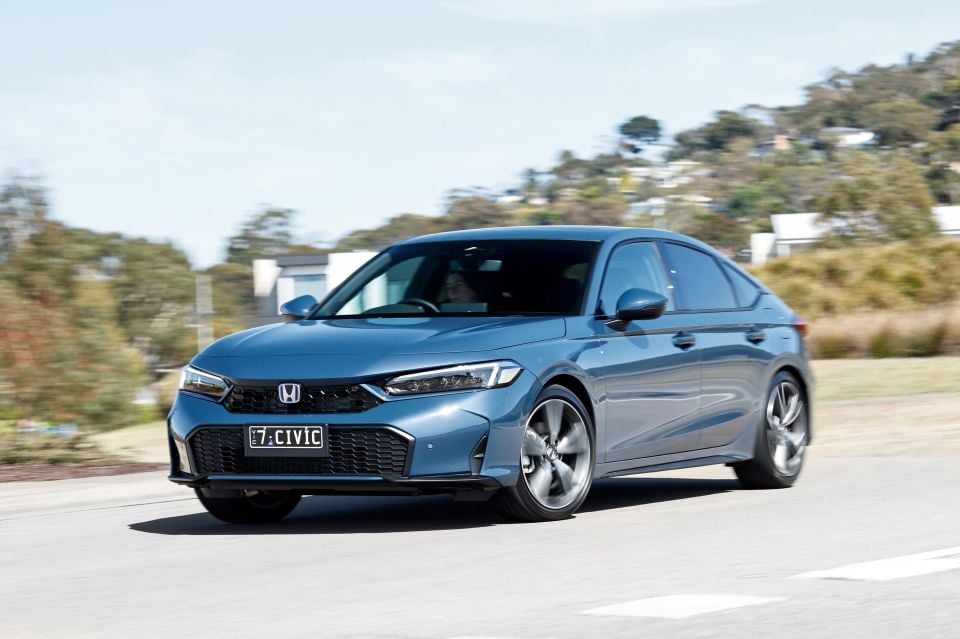
Pictured: Honda Civic e:HEV LX
Sure, you can hear the engine start up when it kicks into life and even more so if you dig deep into the throttle for a fast getaway or when overtaking at highway speeds.
But the transition between running on battery power alone and entering full hybrid mode is totally seamless and more refined than most.
At low speeds, and especially when navigating tight urban areas or heavy traffic, the Civic drives like an electric car most of the time, accelerating smoothly with a faint whir from the electric motor.
The battery discharges quite quickly, but also recoups energy under braking reasonably rapidly when you toggle the paddle shifters for maximum effect of the regenerative braking.
Out on the open road, its remarkable how often the engine shuts down for short bursts of zero-emission running, and then seamlessly wakes up again. Not that you’d know if you weren’t looking at the power flow meter on the digital dashboard or infotainment screen.
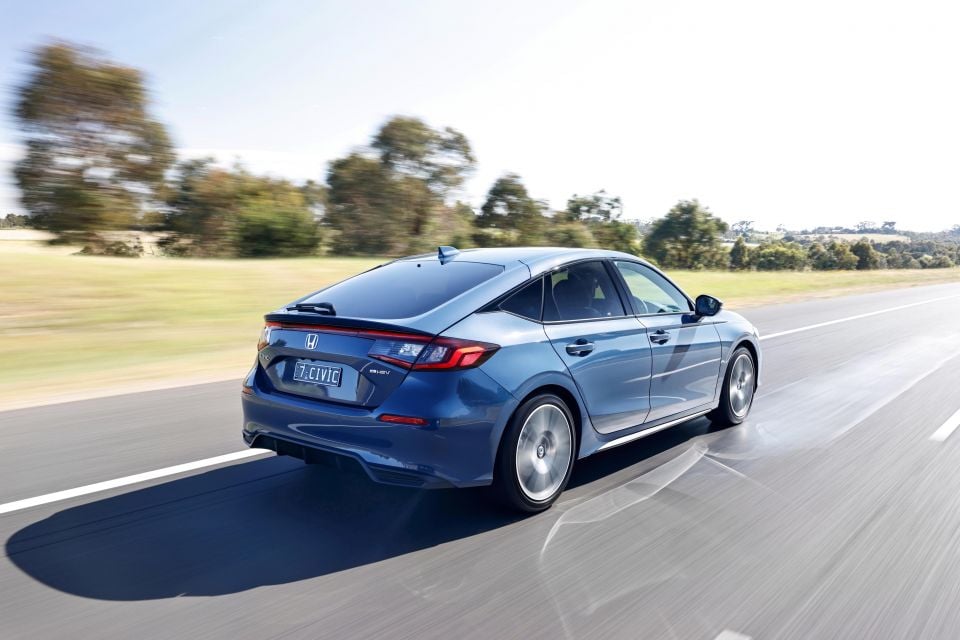
The end result is Honda’s e:HEV system is one of the most refined and effective of its type, delivering an effortless, no-fuss driving experience, and the ability to easily match its claimed fuel economy figure in a mix of city and highway driving.
That same sentiment can be attributed to the rest of the Civic’s driving character. The MacPherson-strut front and multi-link rear suspension is nicely balanced between comfort and confident cornering abilities, and the electric power steering is positive and consistent throughout the arc without feeling overly light or artificially weighted.
No, it’s not as dynamic as the flagship Type R hot hatch, but the bones that make that car such a brilliant track weapon and consummate all-rounder can definitely be felt even in this most basic model.
And it’s quiet too, with excellent suppression of road and wind noise entering the cabin, aided by the audio system’s Active Noise Control function.
To see how the Honda Civic lines up against the competition, check out our comparison tool
With a price tag that pushes to the edge of luxury car territory, you’d expect a lot from even the entry-level Civic.


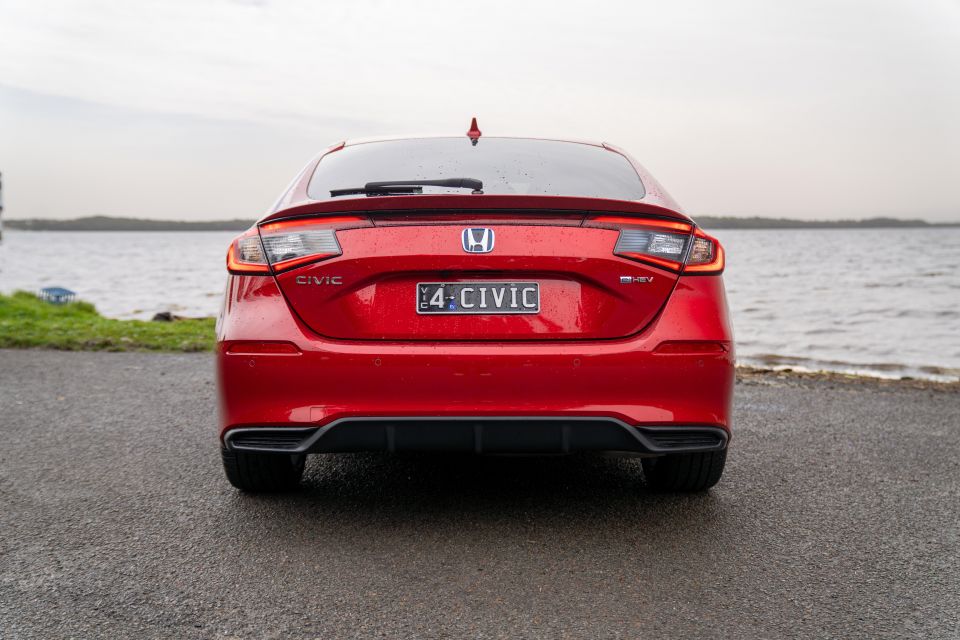

The reality is you that Honda has all the basics covered, but there are no surprise delights.
2025 Honda Civic e:HEV L equipment highlights:
Civic e:HEV LX adds:
To see how the Honda Civic lines up against the competition, check out our comparison tool
The updated Honda Civic retains the maximum five-star ANCAP rating it attracted when it was first introduced in 2022, but now features revisions to improve its comprehensive suite of advanced safety systems.

| Category | Honda Civic e:HEV |
|---|---|
| Adult occupant protection | 89 per cent |
| Child occupant protection | 89 per cent |
| Vulnerable road user protection | 82 per cent |
| Safety assist | 83 per cent |
Standard safety equipent includes:
Similarly to how it drives, Honda has clearly spent considerable time and effort on refining the activation of its safety systems.
Where most of these new functions are annoying, intrusive or over zealous in rival cars – especially the more affordable new entrants – the Civic feels as though they only help when needed, as they should. And, even then, they are smoother and less alarming than most, like a gentle guiding hand rather than a binary brute.
Part of that can attributed to new camera software in the updated Civic, which now also features Honda Connect – a smartphone app that allows owners to remotely start the engine, activate the climate control and find the location of the vehicle, as well as automatic collision detection, which immediately contacts the Honda Help Centre in the event of an impact and can assist emergency services response.
To see how the Honda Civic lines up against the competition, check out our comparison tool
Honda provides a standard five-year warranty with unlimited kilometres and free roadside assistance across its entire passenger vehicle range for private buyers.
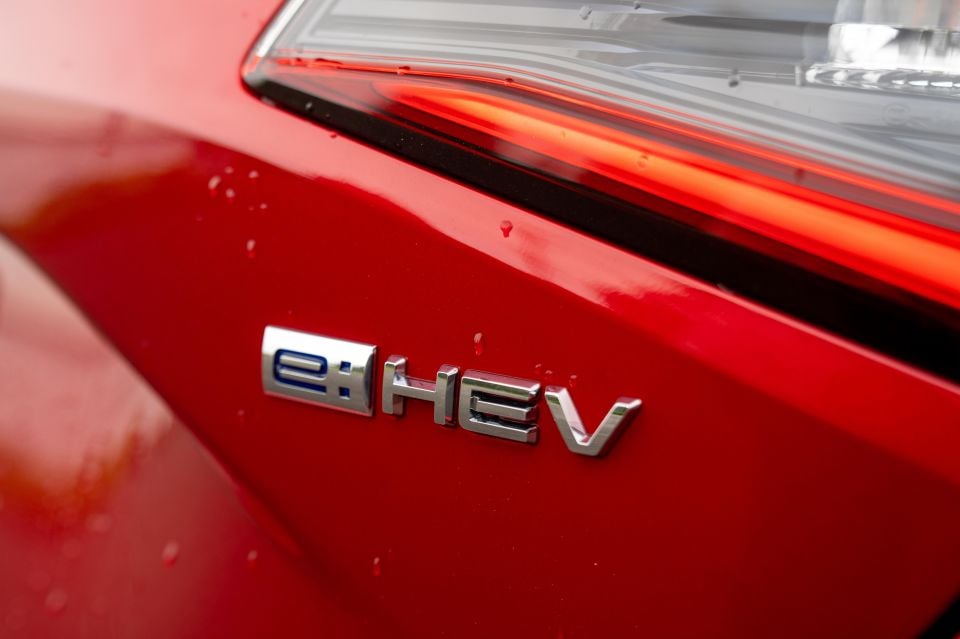
| Servicing and Warranty | Honda Civic e:HEV L |
|---|---|
| Warranty | 5 years or unlimited kilometres |
| Roadside assistance | 5 years or unlimited kilometres |
| Service intervals | 12 months or 10,000km |
| Capped-price servicing | 5 years or 50,000km |
| Total capped-price service cost | $995 |
However, if the vehicle is maintained within the authorised Honda Service network and it meets certain criteria at the end of the initial warranty period, owners can be provided with an additional three years of coverage and roadside assistance, extending the duration to eight years.
Honda also subsidises the first five annual visits to the service centre at just $199 each. But the minimum mileage is only 10,000km between each service, which is less than some rivals.
To see how the Honda Civic e:HEV L lines up against the competition, check out our comparison tool
Buy your new car without the stress. It's fast, simple and completely free.

Great service from Travis and team, second time I have used this business would not hesitate to recommend them to anyone
Craig C.
Purchased a Ford Ranger in Sunshine Coast, QLD
CarExpert helped Craig save $7,224 on his Ford Ranger, now let us save you on your next new car.
Get your BEST pricePutting price aside for one second, the Honda Civic e:HEV L is an exceptional example of a modern small car.
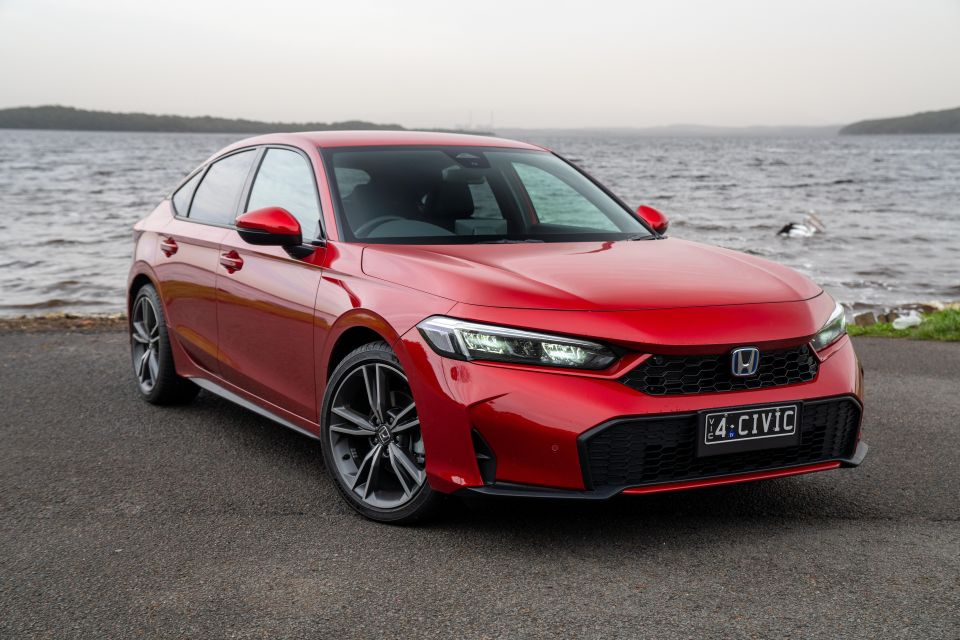
It is spacious, comfortable, quiet, ultra efficient, well built, safe as houses, and very nice to drive. For all the car things it does, it is right up there with the best in the business. It isn’t very exciting, but it’s very, very good.
On top of that, it is affordable to run and, with Honda’s reputation for reliability, feels like it will last a lifetime, which almost justifies its premium price tag.
If you can leap over that hurdle, then the Civic delivers where it matters.
Interested in buying a Honda Civic? Get in touch with one of CarExpert’s trusted dealers here
Click the images for the full gallery
MORE: Everything Honda Civic
Where expert car reviews meet expert car buying – CarExpert gives you trusted advice, personalised service and real savings on your next new car.


Max Davies
5 Days Ago
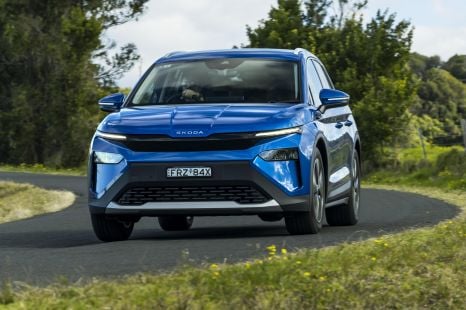

Josh Nevett
3 Days Ago
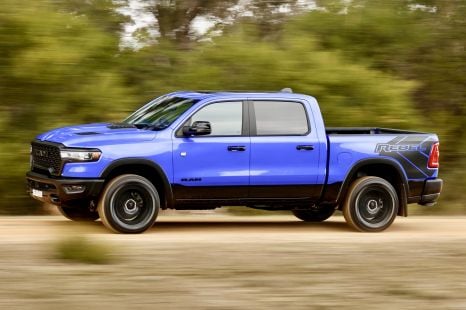

Max Davies
3 Days Ago


Max Davies
2 Days Ago


Derek Fung
2 Days Ago
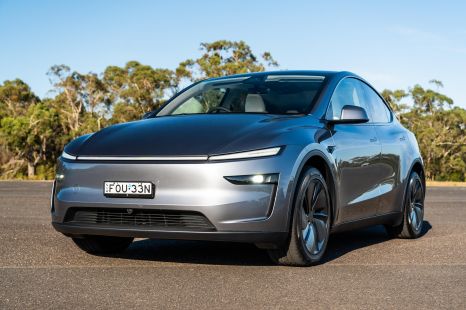

CarExpert.com.au
2 Days Ago